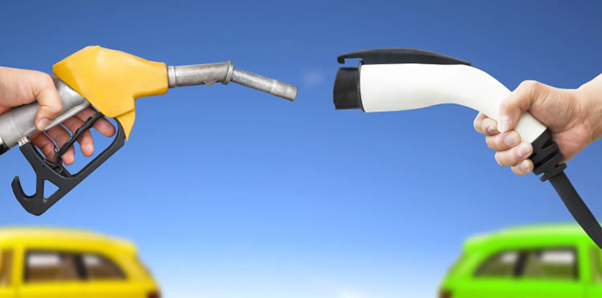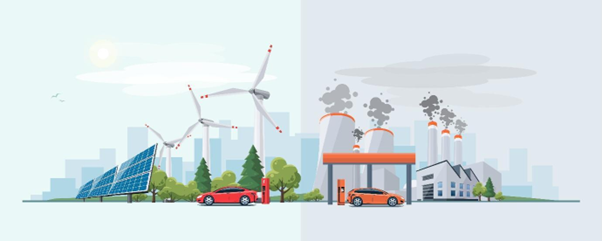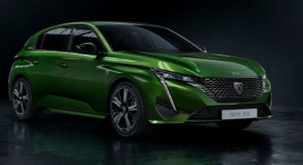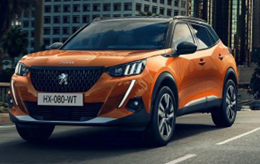What to consider when choosing an Electric Vehicle, TRUE Cost Per Mile
Cost Per Mile – This article investigates the actual cost when choosing between an electric vehicle (EV) and an (ICE) Internal Combustion Engine car.

Cost Per Mile – Market Forces
Calculating costs for fuel and energy can be challenging due to their fluctuating nature. Fuel and energy prices are influenced by various factors, such as supply and demand, geopolitical events, economic conditions, and government policies, which can cause them to change regularly, up and down.
To effectively manage these fluctuations, businesses and households can implement strategies such as fixing prices, which involves locking in prices for a certain period of time, this is not possible with fuel the pumps, and this itself can be a factor when considering making informed decisions and adjusting cost calculations accordingly.
Unhelpful Messaging
Manufacturers don’t help, quoting Internal combustion engines’ fuel efficiency in MPG (miles per gallon) when we buy fuel in litres.
Electric cars also need to be clearer, showing car battery efficiency and power KW rather than quoting miles per Kilowatt hour (kWh), which is how we buy our energy.

Environmental Consideration
Consumption can also vary depending on the car’s fuel efficiency, the price of petrol in your area, and your driving habits.
The availability and accessibility of charging infrastructure in your area can also impact the cost of running an EV. If you have easy access to charging stations, charging your EV can be more convenient and cost-effective.
However, if charging stations are scarce in your area, charging your EV may require additional planning and effort, impacting the vehicle’s overall cost.
Creating a budget that includes these considerations will help you decide whether a particular car fits your budget and financial goals.
I recently stayed at a lovely country inn hotel in North Yorkshire, and the receptionist was proud to announce that there was an EV point within 9 miles!
Depreciation
Cars generally depreciate over time, which means that their resale value decreases.
The depreciation rate can vary depending on the make and model of the car, the overall condition, and the demand for that type of car in the used car market. You don’t have to worry about this if you lease a vehicle.
Depreciation costs are factored into your monthly rental, and regardless of the used car market situation, there is no reproach from the original agreement. To check out FVL’s latest electric lease deals, tap here.
Maintenance and Repairs
All cars require regular maintenance and repairs over time. The costs for these services can vary depending on the make and model of the car, the age and condition of the car, and the specific maintenance or repairs needed.
Regular maintenance can be budgeted as part of your monthly rental while leasing, An opportunity to buy services and parts fixed at today’s price, avoiding inflation. EVs also require less upkeep with far fewer moving parts to worry about.
WLTP Cycle
The Worldwide Harmonised Light Vehicle Test Procedure (WLTP) is a global vehicle testing standard for documenting energy/fuel consumption and CO2 emissions. The phased physical tests are designed to emulate city and open road driving using a 4 -phase test cycle, which gives manufacturers and consumers a “WLTP range” benchmark.
Because we do not drive in a WLTP test cycle, the range will differ according to climate conditions and driving styles.
These differences are exaggerated in Electric Vehicles because of variations in the ambient temperature.
You won’t be surprised to know that not everyone lives in a permanent 23° climate, so it’s worth noting that in this testing method, neither A/C nor heaters are used in the WLTP test.
Usable Battery Capacity
Batteries in electric vehicles vary considerably, and there are two components: a battery capacity and a usable battery capacity.
The gross capacity of a car battery is the amount of storable energy when it is fully (100%) charged. The usable capacity is the amount the manufacturer allows you to use. This can vary depending on the battery quality and chemistry.
Some lithium-ion batteries operate more efficiently when fully charged to 100%, while others degrade quicker if frequently charged at 100%.
To compensate for this, EV manufacturers hold back a proportion of the battery’s capacity to prolong its life, and this energy is not accessible.
An example is the Volkswagen ID4, which has an 82kWh battery, of which the usable amount is 77kWh. VW holds back a 5kWh buffer to extend the battery life.
Make sure to distinguish kWh, a measure of energy, i.e., battery capacity, with kW, which is a measure of power.

Calculating Electric Vehicle Efficiency – Cost Per Mile
To get a helpful metric to quantify the efficiency of an Electric vehicle can be a tongue twister, don’t get confused with the various kilowatt terms.
Most manufacturers use kilometres or miles to show EV range and Wh/km or watt Hour per Km or Wh/mi for miles to show energy consumption and efficiency (WLTP).
Here is an example using the UK or imperial measurement followed by the metric version.
Imperial – 235 Miles (range) 57.kWh (usable battery capacity) = 244 Wh/mi (efficiency)
Metric- 380 km (range) 57.kWh (usable battery capacity) = 155 Wh/km (efficiency)
Electric vehicle efficiency is not necessarily what you want to be shown on your car’s dashboard. Driving economy is this reference point, shown as kWh/100mi (per mile) or per Km; this measures the car’s economy from the energy stored in the battery. Economy combines the vehicle’s efficiency, total weight, powertrain, aerodynamics, driving conditions and style.
Driving Economy
This confusion it’s not helped by many websites and publications that mix up the two.
“The Megastar EV has a WLTP efficiency of 15.6 mi/Wh, but we managed to achieve 14.5 kWh/100m.”
The previous example of the Tesla at 244 Wh/mi efficiency would show as 2.44 kWh/mi—plus or minus real-time driving.
From my own experience with a Mini Electric, the WLTP (efficiency) figure is 2.63 Wh/mi; in reality, I achieve 3.8 mi/kWh, and I don’t particularly drive in a conscious, economical fashion.
Calculating Running Costs – Average – Cost Per Mile
Good practice, when choosing a car to lease, fix a budget and then consider your options; for this example, we have chosen a budget of Circa £350 plus £22 for maintenance.


- Peugeot 308 Hatchback 1.2 Pure Tech Allure EAT8 131 bhp 43.50 mpg (Combined)
- Peugeot GT E-2008 Electric Estate 46.3 kWh range 160 Efficiency 289 mi/kWh or Economy of 2.89 mi/kWh (WLTP)
Petrol Cost April 2023 Average £1.47 per litre or £6.71 per gallon = £0.15p per mile at 43 mpg
*At time of writing.
Electric costs current Government Cap Home charge 34p* per kWh = £0.11p per mile.
*At time of writing and check with your supplier; off-peak rates can be as low as £0.07.5p (OctopusApril 23)
Fast charge Public 22-50 kWh at 49p per kWh = £0.16p per mile
Rapid Public Charger 100-300 kWh Average 79p* per kWh = £0.27p per mile
*Government Business support is due to end; the price is anticipated to rise to £0.98p (Genie Point)
| Per Litre | CPM | Peugeot 308 Petrol | Peugeot GT Electric | Per kWh | Provider |
| £1.47 | Cost Per Mile | £0.15p | £0.03p | 0.07.5p per kWh | Octopus April 23* |
| £1.47 | Cost Per Mile | £0.15p | £0.11p | 34p per kWh | Home** |
| £1.47 | Cost Per Mile | £0.15p | £0.16p | 49p per kWh | Fast public charger # |
| £1.47 | Cost Per Mile | £0.15p | £0.27p | 79p per kWh | Rapid public charger # |
| £1.47 | Cost Per Mile | £0.15p | £0.34p | 98p per kWh | Genie point^ |
Conclusion on costs & miles you can travel
In conclusion, the cost of running an electric vehicle can be lower than a petrol-engine car due to lower fuel (off-peak) and maintenance costs, higher energy efficiency, ULEZ exemptions, and potential government incentives.
However, when comparing the costs of running an EV versus a petrol-engine car, it’s essential to consider your specific circumstances, including your location, driving habits, and available charging infrastructure.
Importantly, if you want to decrease your mobility cost and are considering alternative fuels, our cost figures can only guide you at a single point in time.
In summary, it would be best to look at your overall motoring pattern to get a more accurate picture relevant to total £s and pence.
Leasing is an excellent option for fixing costs with no depreciation concerns, fixed monthly payments, and inclusion of road tax, and the option of an inclusive maintenance package.
